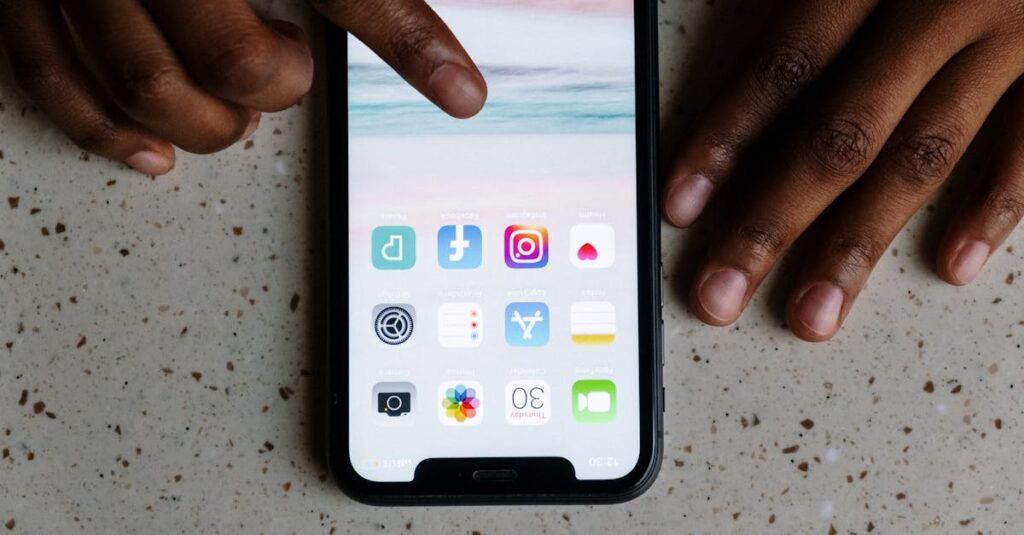Table of Contents
ToggleIn a world where iPhones and Androids are like cats and dogs—best friends but never meant to share a bed—one question looms large: can you share notes between these two tech titans? Picture this: you’ve got a brilliant idea jotted down on your iPhone, but your buddy’s rocking an Android. Suddenly, that genius thought feels as unreachable as the last slice of pizza at a party.
Overview of Note Sharing
Sharing notes between iPhone and Android devices presents distinct challenges. Firstly, both platforms utilize different note-taking applications, which complicates direct sharing. Apple’s Notes app offers various features and integrations that are exclusive to their ecosystem. In contrast, Android devices typically utilize Google Keep or other third-party apps, resulting in compatibility issues.
When sharing a note, consider the format. iPhone users may find that directly sharing an Apple Note leads to accessibility issues on Android. Instead, exporting notes as PDFs or text files ensures a smoother exchange. Users should recognize the importance of selecting formats that are universally accessible.
Additionally, cloud services provide a workaround. Utilizing services like Google Drive or Dropbox allows both iPhone and Android users to access shared notes. Creating a shared folder enables seamless collaboration, regardless of their device type.
Many third-party apps bridge the gap effectively. Apps like Evernote and Microsoft OneNote support both platforms. Those opting for these applications gain the advantage of cross-platform functionality, simplifying the sharing process.
Exploring communication methods also aids in sharing notes. Email allows users to send notes directly as attachments, while messaging platforms enable quick sharing. This flexibility can eliminate some of the frustration associated with incompatible formats.
While challenges exist in sharing notes between iPhone and Android, various solutions streamline the process. Users benefit from understanding these options, improving collaboration across devices.
Apple Notes on iPhone
Apple Notes serves as a powerful tool for capturing ideas and organizing thoughts on the iPhone. Users appreciate its clean interface and intuitive features, designed to enhance productivity.
Features of Apple Notes
Notable features of Apple Notes include seamless integration with other Apple products and services. Users can create checklists, add images, and sketch within their notes. Collaboration remains easy, allowing multiple users to edit notes simultaneously. Users benefit from end-to-end encryption for added security and accessibility across devices. Moreover, search functionality enables quick retrieval of specific notes, ensuring users find essential information swiftly.
Limitations of Apple Notes
Apple Notes presents some limitations that can hinder sharing with Android users. The app only functions within the Apple ecosystem, making cross-platform sharing challenging. Exclusive features may not translate well when exported to other formats. Users might encounter difficulties when trying to export notes directly to formats recognized by Android devices. Moreover, some third-party integrations may lack compatibility, further complicating user experience when sharing notes with Android friends.
Android Notes Applications
Android offers a variety of note-taking applications that cater to different user preferences and needs. Popular choices include Google Keep, Microsoft OneNote, and Evernote, each designed with unique features to enhance productivity.
Popular Note Apps for Android
Google Keep excels in simplicity, enabling users to create notes and reminders effortlessly. Microsoft OneNote provides a more robust structure, allowing for extensive organization through notebooks and sections. Evernote stands out with its powerful search capabilities and organization tools. Users seeking collaboration appreciate that these apps often support shared notes and editing, fostering teamwork. Each application empowers users to capture ideas quickly and sync data across devices, enhancing accessibility.
Compatibility with iPhone Notes
Compatibility between Android note apps and iPhone’s Notes application varies considerably. Google Keep allows easy sharing with iPhone users via links, providing a smooth user experience. Evernote supports importing Apple Notes but may strip formatting in the process. Microsoft OneNote, while compatible, may require syncing issues to be resolved for fluid collaboration. For best results, users can export notes from iPhone in PDF or text format to ensure they appear correctly on Android devices. Acknowledging these nuances helps bridge the gap when sharing notes across platforms.
Methods to Share Notes from iPhone to Android
Sharing notes between iPhone and Android devices poses several challenges. However, various effective methods exist to facilitate the process.
Using Third-Party Apps
Third-party apps simplify the process of sharing notes. Applications like Evernote, Microsoft OneNote, and Google Keep allow seamless exchanges across platforms. Evernote supports importing notes from Apple Notes but may strip some formatting during the process. Microsoft OneNote provides robust organizational options, although syncing issues can arise. Google Keep’s simplicity allows users to share notes via links, making it easy for Android users to access content without hassle. These apps enhance collaboration for both iPhone and Android users.
Exporting Notes as PDF or Text
Exporting notes from iPhone in PDF or text formats fosters compatibility. To ensure proper display on Android devices, users can select these formats. Apple Notes allows users to export individual notes easily by tapping the share function and choosing PDF or plain text options. PDF files retain formatting, making them perfect for sharing complex layouts. Text files offer a straightforward, universally compatible approach. By exporting notes, individuals prevent the formatting issues that often arise when sharing directly between apps.
Challenges in Sharing Notes
Sharing notes between iPhone and Android devices presents several challenges. Users often encounter difficulties due to differing file formats and app functionalities.
Formatting Issues
Formatting issues frequently arise when sharing notes across platforms. Apple’s Notes app includes exclusive features that don’t translate well to Android. Exporting notes as PDFs or text files can minimize these problems. Many Android apps, like Google Keep, sometimes strip formatting during imports, altering the original layout. Ensuring compatibility often means additional work for users, as important elements may lose their intended design and context. Recognizing the limitations of each platform enhances the overall sharing experience and reduces frustration.
Syncing Problems
Syncing problems may complicate the sharing process, especially when users switch between devices. Frequent updates in apps can lead to inconsistencies in note availability. For instance, Microsoft OneNote requires users to solve syncing issues to maintain collaboration. When using cross-platform apps, users might experience delays in reflecting recent changes, which can hinder effective communication. Different cloud services can cause discrepancies in the synchronization process, illustrating the importance of selecting reliable platforms for note sharing. Managing these syncing difficulties can facilitate smoother exchanges between iPhone and Android users.
Navigating the world of note sharing between iPhone and Android devices can be tricky. Despite the inherent challenges posed by different ecosystems there are effective strategies to bridge the gap. Utilizing third-party apps and cloud services can significantly enhance collaboration. By exporting notes in universally compatible formats users can ensure their ideas are accessible regardless of the device.
With the right tools and approaches sharing notes can become a seamless experience. Embracing these solutions not only simplifies communication but also fosters creativity and collaboration across platforms.







